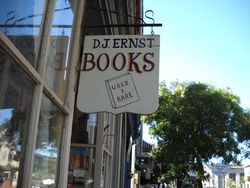
In Selinsgrove, Pennsylvania, nestled on North Market Street, sits a bookstore that’s been serving its community for 44 years. In its display windows, used books surround electric candles, inviting passersby to peer in and, just maybe, walk amongst the books that line the shelves within. Hanging beside the receding door is a wooden, weather-worn sign, welcoming potential customers with the name of the bookstore: DJ Ernst Books, Used & Rare.
Donald J. Ernst—known to the students and faculty of the nearby Susquehanna University as “Homer”—has owned and operated the single-room store since he was a college student in the 1970s. Looking around the space, there’s an ever-present sense that this is a place in which time stands still, and the once-forgotten is given a spotlight. From the cloth-bound collections to the vintage orange-crate shelves to the old cash register that came with the store, DJ Ernst proudly shows its age and revels in its history.
Age, history, and a “classic” status are important features in the types of literature Ernst keep in his store. With the books being used or rare copies, it’s clear that many of these books have histories we can only begin to imagine. For DJ Ernst, literature is made up of well-written classics that both reflect Homer’s personal taste and the tastes of the communities he serves.
The Past
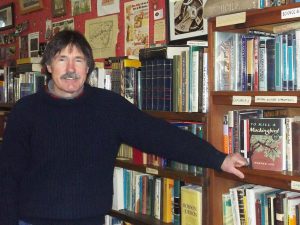
The bookstore was first established on February 1st, 1975. Ernst’s father had always had a passion for literature as he enjoyed collecting and reselling books out of his house. He passed down this joy to his son as they began to bond over literature in the ’60s. As their passion grew, Ernst’s father decided to open the very store that still stands today and is now owned by his son.
In the text “A Global Sense of Place,” Tim Cresswell reiterates Massey’s definition of place as, “[a] site of multiple identities and histories” (72). From what was previously a women’s shoe store, to what is now known as DJ Ernst Books, it is safe to say this particular building has been filled with multiple identities and histories. To add to this, along with the building, Ernst was also left with an antique cash register that is still there today.
The contents of the store are in a way a part of a time capsule, one formed when Market Street started to slow down. Preserving “Old Selinsgrove” became the store’s aesthetic. The memorabilia hanging on the walls–the postcards, the pictures of his family, the articles cut outs from newspapers about his store, the multiple maps of Pennsylvania–are points in his timeline that makes up Ernst’s time as a bookseller. The antique cash register is a tribute to a time when Market Street was busy, before the mall was built on 11/15. It is one of the oldest stores on Market Street and it proudly shows.
One of Ernst’s many interests is used, rare books, and he’s not alone. Antique books are some of the staples of the store. Throughout the years he has managed to find a signed copy of a Robert Frost book, as well as a signed Walt Whitman Leaves of Grass. These old books help define what literature is in Homer’s definition. To further explain what his definition of literature is, it is well-written classics and antique books that both reflect his personal taste as well as the tastes of those within the community. Ernst says he stocks books that he believes are interesting and are worth passing the knowledge on to others or are books everyone should read at least once in their life. I can agree with that.

While other stores in Market Street have struggled to stay open through the years, DJ Ernst has persisted. The store has expanded by creating an online presence. In the early 2000s when he joined Biblio and Abebooks, it allowed him to accept credit cards and to sell worldwide. He also created a Facebook page, where he posts books that he finds and updates his customers on what he has in stock. However, he never added a credit card scanner to the physical store. It was not part of the environment he wanted to have. Homer wants to keep the good parts of the history in his store and allow customers to experience it by purchasing the classics that he has for sale.
The Bookstore
The structure of the store is a clear layout of self-identity embodying a living and breathing time capsule of classics. Looking into this time capsule is a large “timeline” of Ernst finding out who he was, but also learning what has molded his experience into the bookseller that he is today.
Ernst’s store embeds various versions of his history through the structure and layout he provides within the store. At first glance you see a giant, awkwardly shaped display of books smack in the middle of the store. This shelf is made up of small and tall shelves, a table, and a couple of random wooden pieces placed nicely together. This system holds a variation of books that are displayed either facing you when you first walk in, spine out, or even the cover facing up. It is not the type of shelving you would see at a chain bookstore since they would display their books in rows and columns of straightforward shelving, but there is true character behind this funky shape that makes his system so attractive. It is almost as if each piece was put there at a different time in his life, expanding the ability to display his collection of books.
This giant mix-matched shelving is shifted a little to the left when you walk in. Peering through the right-side window enables the customer to face Ernst as he sits at his front counter. As an assumption, Ernst was probably trying to find the best way to display the most amount of books that he had, so his system of this awkward shelving worked for him and his store. Ernst cleverly placed the shelving in the center forming a pathway around the perimeter of his store, which directs the overall traffic throughout the building. This is a creative way to keep the viewer intrigued and their eyes constantly active, making it easier for a consumer to get “lost” within the store. Regardless of if the customer was to start their journey on the right or left side of the store they always walked around the entire perimeter either once, or multiple times.
Most books are placed on the shelves, but there are also three rows of books stacked on the floor, spine up, and in front of the shelves filling the perimeter of the store. Whether you look up to the ceiling, or down to your feet the place is completely covered in books. Ernst talks about not really knowing how to be a bookseller when he started out and this experience stemming from a passion that he shared with his father. You can tell by the setup of the store that Ernst doesn’t look into the nit-picky details of how to organize the business; it is merely groomed out of that hobby that he formed the store from.

Ernst mentioned how he is a “specialist in early Pennsylvania history and local history,” which is not apparent until truly digging into the identity of the store. You can tell that he is proud of the accomplishments through the various newspapers and articles hanging around the room. Whether it is a shout out from the town’s newspaper, or him and his father inside the store, every moment has been captured and hung up. You can tell that Ernst holds things close to him through the way he has structured his store and his layout.
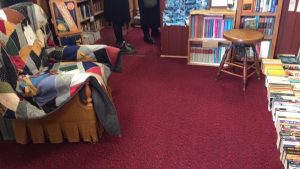
An example of such would be how Ernst has placed the chair facing the front counter that he sits behind. He mentions that individuals from the Selinsgrove community always come in and sit on the worn-out rocking chair with a colorful knitted blanket to talk for hours. It could range from talking about Philosophy to WWII and even for some, a trip after the bar for a “how are you” conversation. And most times these community members leave his store empty-handed, but the openness that Ernst gives for a conversation and a place to sit back and relax makes the community feel welcome. He never passes on the opportunity to learn new things as he helps his customer’s branch out on topics that they are interested in. When thinking about this generation, it is known for basing basic communication skills off of technology whether it is texting or even email. Ernst holds onto the past when facing the chair towards his desk only forcing this “abnormal” form of communication to occur. Whether it is the structure of his store or the things that embedded within it, the history is apparent, and it is not going away as long as Ernst is there.
Within DJ Ernst Books, the collections of books themselves are perfectly indicative of the bookseller and
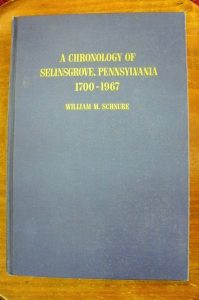
the community surrounding him. DJ Ernst Books is clearly not a typical bookstore, at least, not in the way modern consumers understand them to be in the world of corporate stores and standardized inventories. In true fashion of the personal bookstore, Homer doesn’t refer to popular bestsellers lists to stock his shelves. His collections differ greatly from the standardized models of corporate bookstores and his inventory is not motivated by profit or marketability. Personal bookstores almost always differ from corporate ones in this sense, as seen in Reluctant Capitalists by Laura J. Miller. Like many other personal bookstores, DJ Ernst Books is, instead, purely a reflection of the owner’s taste, interests, preferences, and distinct definitions of literature.
Those distinct definitions, however, can be difficult to discern with the way the collection is organized throughout. DJ Ernst has subgenres and niche categories galore, all fit in tightly with each other in this small space. If the collection is supposed to reflect the bookseller’s tastes in literature, the only thing that becomes clear upon entering is that DJ Ernst loves to read as many books as he can. Children’s Illustration Books are next to Ancient History, books on music are near books on war, and on the other side of the store, there are hunting books next to American Literature, as well as reports of historical explorations next to World Literature. Many people are so used to walking into a bookstore and finding nothing but modern bestsellers and the most popular books hot off the presses. DJ Ernst Books, however, overflows with books from a wide array of genres, time periods, and aesthetics.
The other thing that becomes immediately clear is that Homer has a deep respect for the book itself as a material. While there is an almost overwhelming number of subgenres, all of them are clearly defined in handwritten labels, and many other labels pasted throughout the space are handwritten warnings to treat the books with great care, as if they were made of glass. It’s clear that Homer values the book as a special kind of object, which is also evident in the aesthetics of the books he chooses to place on high, important pedestals and shelves. There are antique, leather-bound books, and more rare and ornate tomes presented in high places, in the center display for people to admire, or even in the back shelves away from customer’s hands. However, on the other hand, the simple paperbacks are lined up in rows on the floors in front of most of the bookcases.
Most notably is the sheer number of historical genres, especially on the left side of the store. From history books on the wars big and small, to Pennsylvanian history, and even a section just labeled “Europe,” it is clear that the past and knowledge are immensely important to Homer. This is clear in almost everything about this personal bookstore, such as the unchanged interior design and the ancient cash register on the counter. He has even kept a magazine from decades before where regional collectors and booksellers such as himself could keep in touch and share product, despite the magazine being obsolete now and many of those contacts outdated. This is why the bookstore isn’t categorized with genres like fantasy, science fiction, romance, or self-help. Homer isn’t interested in these kinds of books, and he doesn’t tend to stock them unless they stand out to him or he knows one of the regular customers might be interested. Instead, the definition of literature presented in this bookstore’s collection reflects the classics and the unique, especially if they are reminiscent of an older era.
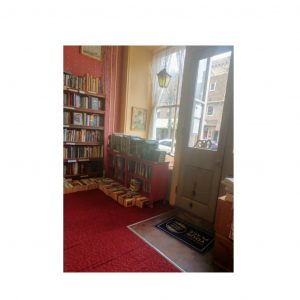
In addition to the bookstore’s personal taste, Homer attributes a lot of his inventory to other people in the surrounding Selinsgrove area and many of his contacts who are collectors. DJ Ernst Books isn’t solely a reflection of the bookseller’s personal taste but also a reflection of the community it is so ingrained in. For example, if this was just a personal bookstore, there wouldn’t be any sci-fi paperbacks, seeing as how Homer doesn’t like the genre. This also explains the hunting books, the books about fishing and nature, as well as books written by faculty from the creative writing department at Susquehanna University. Ultimately, DJ Ernst Books is a personal bookstore whose collection reflects the personal taste and identity of the bookseller, just as people are products of their communities.
:
The Present
While the number of independent bookstores is on the decline, one that still remains today on Market Street is DJ Ernst Books.
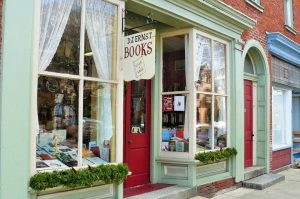
At D.J. Ernst Books, people don’t come just for the books, they visit for the conversations with Homer. Also, people visit for the unique and personalized experience that only an independent bookstore can create. In his book The Yellow-Lighted Bookshop, Lewis Buzbee reflects on this idea. Buzbee explains, “My excitement at being in a bookstore comes from the place itself, the understanding that I can stay here for as long as need be” (4). Unlike other book merchants eager to make a sale, Homer doesn’t rush his customers. People are free to browse until the store closes. Buzbee as a bookseller reminds me of Homer, as both gravitate towards old paperbacks, talk freely with their customers, and create a helpful atmosphere in the store. When Buzbee talks about the “excitement” of the bookstore coming from the sense of place, Homer’s bookstore fits this description. The “excitement” of Homer’s bookstore is the atmosphere the store creates, a sense of home. It’s the comfortable and relaxed atmosphere of an independent bookstore that makes it feel homey.
When looking back on how Homer defines literature, Buzbee touched on another concept. His definition of good literature can be summed up in this quote: “I fall into these worlds again, not as much for the enchantment, but for the familiarity” (35). Homer believes that literature is defined as classic books, the “familiarity” stories that many generations have read. Similar to Buzbee, Homer believes in the power of the familiar, that these old books have a reason for maintaining their celebrated status. Homer has built his business around the classic paperback favorites that keep customers engaged with the store, the books that are the most “familiar.”
Another bookseller that reminds me of Homer is Kathleen in the film You’ve Got Mail (1998). Kathleen runs an independent bookstore and she knows all her customers by name. Although her store in the film appears nothing like Homer’s décor, they both appeal to a local audience. Kathleen runs a children’s bookstore and recommends her favorite books to her customers. Homer runs an independent bookstore that’s frequented by mainly college students and retired residents of Susquehanna. What makes these two booksellers similar is their passion for good literature, the quality content between the covers.
A more specific example of what Homer defines as literature is his selection of John Steinbeck novels. Homer himself has been recently discovering Steinbeck’s works. He stocks them now because he’s reading all the works and discussing them with customers. Buzbee commented on Steinbeck by writing that “John Steinbeck has always been a controversial writer. More of his works have been banned than those of nearly any other American writer in the last sixty years” (42). It’s this attention, this acknowledgment that Steinbeck’s books have been read by so many, that Buzbee uses to define the work as literature. Homer doesn’t care whether Steinbeck is “controversial” or not, because he enjoys the books and the response they receive from customers. Since people of all ages and generations have read Steinbeck and enjoyed his work, it is good literature to Homer. Homer defines good literature by how his customers respond to the work in question, his opinions on it, and the impact the book has had on the world. It’s the relaxed atmosphere, the familiar books, and the excellent customer service that makes Homer’s store so special to locals.
Conclusion
What makes a book or a type of literature a “classic” is highly personal. At DJ Ernst, that personal understanding of classic literature–old, rare, and well-written–mixes with the wants and needs of Selinsgrove residents, Susquehanna students and faculty, and the people of Snyder County. This store’s stock, then, creates a beautiful union between the past and the present that can stand the test of time.
Sources
Film:
Graphics:
Floor plan by Erin Reid, created via ThingLink
Map by Monet Polny, created via Google
Photos by Erin Reid, Valerie Erickson, Monet Polny, Laurel Jakucs, Ty Bricker, and Eneida Giboyeaux
“DJ Ernst.” New Timeline – Timeline, time.graphics/line/234048.
Text:
Buzbee, Lewis. The Yellow-Lighted Bookshop A Memoir, A History. Graywolf Press, 2008.
Cresswell, Tim. “Place: A Short Introduction” A Global Sense of Place. Off Our Backs: pg. 72. Print
Miller, Laura J. Reluctant Capitalists Bookselling and the Culture of Consumption. University of Chicago Press, 2014.


0 Comments